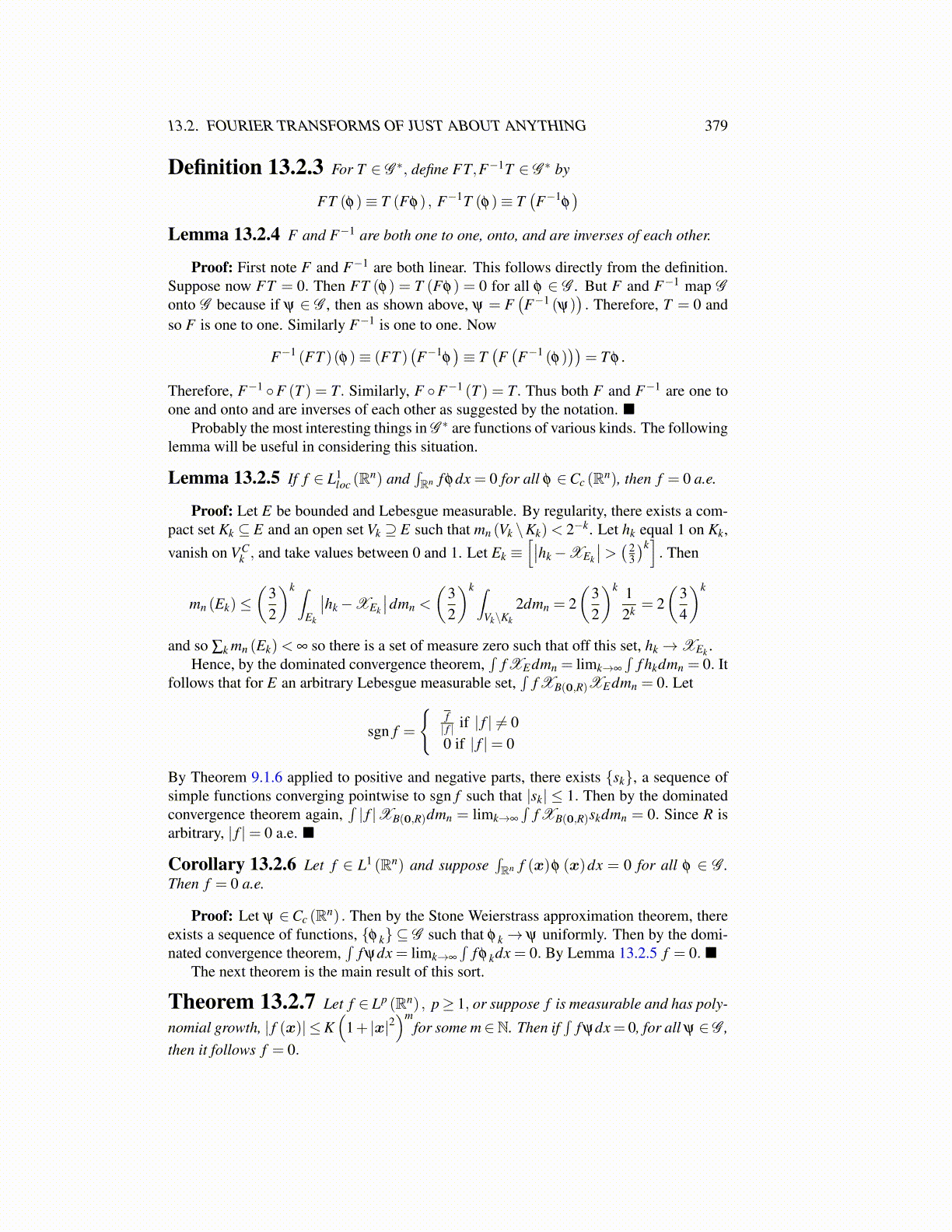
13.2. FOURIER TRANSFORMS OF JUST ABOUT ANYTHING 379
Definition 13.2.3 For T ∈ G ∗, define FT,F−1T ∈ G ∗ by
FT (φ)≡ T (Fφ) , F−1T (φ)≡ T(F−1
φ)
Lemma 13.2.4 F and F−1 are both one to one, onto, and are inverses of each other.
Proof: First note F and F−1 are both linear. This follows directly from the definition.Suppose now FT = 0. Then FT (φ) = T (Fφ) = 0 for all φ ∈ G . But F and F−1 map Gonto G because if ψ ∈ G , then as shown above, ψ = F
(F−1 (ψ)
). Therefore, T = 0 and
so F is one to one. Similarly F−1 is one to one. Now
F−1 (FT )(φ)≡ (FT )(F−1
φ)≡ T
(F(F−1 (φ)
))= T φ .
Therefore, F−1 ◦F (T ) = T. Similarly, F ◦F−1 (T ) = T. Thus both F and F−1 are one toone and onto and are inverses of each other as suggested by the notation. ■
Probably the most interesting things in G ∗ are functions of various kinds. The followinglemma will be useful in considering this situation.
Lemma 13.2.5 If f ∈ L1loc (Rn) and
∫Rn f φdx = 0 for all φ ∈Cc (Rn), then f = 0 a.e.
Proof: Let E be bounded and Lebesgue measurable. By regularity, there exists a com-pact set Kk ⊆ E and an open set Vk ⊇ E such that mn (Vk \Kk)< 2−k. Let hk equal 1 on Kk,vanish on VC
k , and take values between 0 and 1. Let Ek ≡[∣∣hk−XEk
∣∣> ( 23
)k]. Then
mn (Ek)≤(
32
)k ∫Ek
∣∣hk−XEk
∣∣dmn <
(32
)k ∫Vk\Kk
2dmn = 2(
32
)k 12k = 2
(34
)k
and so ∑k mn (Ek)< ∞ so there is a set of measure zero such that off this set, hk→XEk .Hence, by the dominated convergence theorem,
∫f XEdmn = limk→∞
∫f hkdmn = 0. It
follows that for E an arbitrary Lebesgue measurable set,∫
f XB(0,R)XEdmn = 0. Let
sgn f =
{f| f | if | f | ̸= 00 if | f |= 0
By Theorem 9.1.6 applied to positive and negative parts, there exists {sk}, a sequence ofsimple functions converging pointwise to sgn f such that |sk| ≤ 1. Then by the dominatedconvergence theorem again,
∫| f |XB(0,R)dmn = limk→∞
∫f XB(0,R)skdmn = 0. Since R is
arbitrary, | f |= 0 a.e. ■
Corollary 13.2.6 Let f ∈ L1 (Rn) and suppose∫Rn f (x)φ (x)dx = 0 for all φ ∈ G .
Then f = 0 a.e.
Proof: Let ψ ∈Cc (Rn) . Then by the Stone Weierstrass approximation theorem, thereexists a sequence of functions, {φ k} ⊆ G such that φ k→ ψ uniformly. Then by the domi-nated convergence theorem,
∫f ψdx = limk→∞
∫f φ kdx = 0. By Lemma 13.2.5 f = 0. ■
The next theorem is the main result of this sort.
Theorem 13.2.7 Let f ∈ Lp (Rn) , p≥ 1, or suppose f is measurable and has poly-
nomial growth, | f (x)| ≤K(
1+ |x|2)m
for some m∈N. Then if∫
f ψdx= 0, for all ψ ∈ G ,then it follows f = 0.